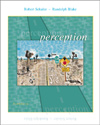 |  Perception, 4/e Robert Sekuler,
Brandeis University
Randolph Blake,
Vanderbilt University
Action and the Perception of Events
Chapter Outline- STRUCTURE FROM MOTION
- BIOLOGICAL MOTION
- Recognizing Biological Motion
- VISUAL GUIDANCE OF LOCOMOTION
- Finding the Right Direction
- Judging Your Tine of Arrival
- Locomotion and Movement Without Vision
- EYE MOVEMENTS: THEIR AIMS AND EFFECTS
- Acquiring the Target
- Saccadic suppression
- Perceptual stability
- Staying on Target: Keeping Your Eye on the Ball
- BUILDING DIRECTIONAL SELECTIVITY: SPACE-TIME RECEPTIVE FIELDS
- APPARENT MOTION
- The Correspondence Problem in Motion Perception
- The Aperture Problem
- Area MT's Special Role in Motion Processing
- Motion Adaptation
- HIGHER-ORDER EFFECTS IN MOTION PERCEPTION
- Attending to Objects That Are Not Really There
|
|



 2002 McGraw-Hill Higher Education
2002 McGraw-Hill Higher Education